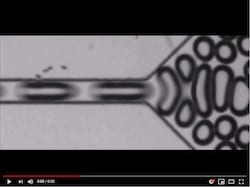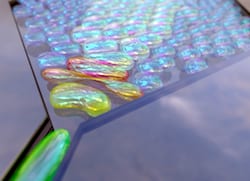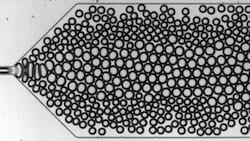NEWS RELEASE
Editor’s note: Links to video and high-resolution images for download appear at the end of this release.
David Ruth
713-348-6327
david@rice.edu
Mike Williams
713-348-6728
mikewilliams@rice.edu
A video shot at more than 30,000 frames per second shows how bubbles generated in a microfluidic device “pinch” one another as they create a foam. Rice University engineers made the devices to generate foam with bubbles in two or three distinct sizes. Courtesy of the Biswal Lab
Tiny bubbles break each other up
Rice University engineers demonstrate mechanics of making foam with bubbles in distinct sizes
HOUSTON – (Dec. 6, 2018) – It’s easy to make bubbles, but try making hundreds of thousands of them a minute – all the same size.
Rice University engineers can do that and much more. Rice chemical and biomolecular engineer Sibani Lisa Biswal and lead author and graduate student Daniel Vecchiolla have created a microfluidic device that pumps out more than 15,000 microscopic bubbles a second and can be tuned to make them in one, two or three distinct sizes.
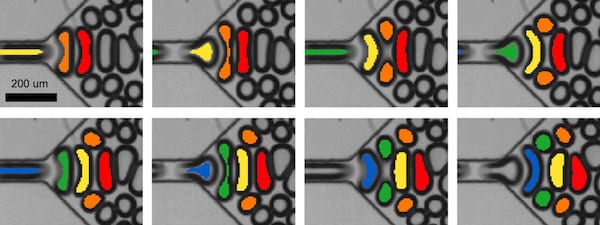
A sequence shows the progression of bidisperse foam generation in a microfluidic device created at Rice University. When bubbles enter, they pinch the preceding bubble into two before becoming a wall against which the next bubble will be pinched. Courtesy of the Biswal Lab
The work featured on the cover of the Royal Society of Chemistry journal Soft Matter enables customizable, “wet” foams in small amounts for applications that include chemical and biological studies.
The best part is that the bubbles themselves do the hard part.
A movie that demonstrates the mechanism shows elongated bubbles shooting through a tube into an input channel. Each arrow-like bubble moves with enough force to split the bubble ahead of it, but the arrow remains intact. It takes its place between the new “daughter” bubbles and becomes a “wall” that holds the next bubble in place for splitting. In that way, only every other bubble entering the expansion splits from the inter-bubble forces.
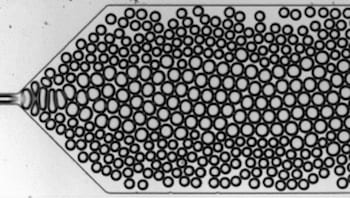
A foam with bubbles in two distinct sizes is contained in a microfluidic device created by Rice University engineers. The device can create more than 15,000 bubbles a second. Courtesy of the Biswal Lab
Vecchiolla described the process as “metronomic,” the tick being a bubble splitting and the tock a bubble that remains whole.
When the input is centered and all the other parameters – the type of liquid, its viscosity, the flow rate and the width of the channel – are right, the device fills with large bubbles in the middle and two ranks of identical, smaller bubbles along the edges. When the input is offset, the stream produces bubbles in three sizes.
“There’s interest in using monodisperse bubbles for material applications and miniaturized reactors, so there’s been a lot of studies about the generation of uniformly sized gas bubbles,” Biswal said. “But there have been very few that looked at using neighboring bubbles to create these daughter bubbles. We’re able to generate well-ordered foam systems and control the size distribution.”
Recent alumna Vidya Giri helped create the microfluidic channels, which are about one-twentieth of an inch wide with a feeder channel of about 70 microns.
Biswal is an associate professor of chemical and biomolecular engineering and of materials science and nanoengineering. The National Science Foundation supported the research.
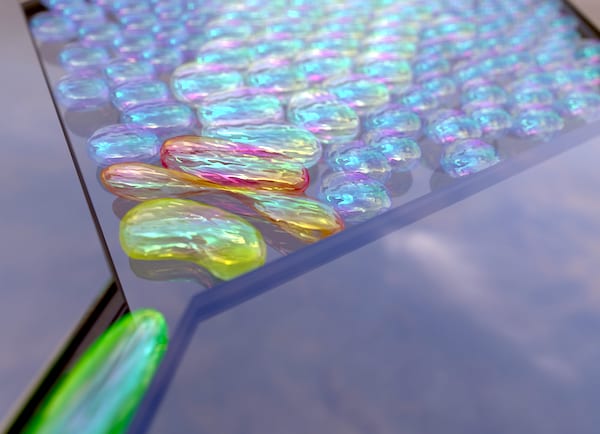
An illustration shows the mechanism by which foam with bubbles in two distinct sizes is created in a microfluidic device. Rice University engineers discovered the technique to make foam with bubbles in two or three distinct sizes. Illustration by Eric Vavra/Biswal Lab
-30-
Read the abstract at https://pubs.rsc.org/en/content/articlelanding/2018/sm/c8sm01285g#!divAbstract.
Follow Rice News and Media Relations via Twitter @RiceUNews.
Video:
A video shot at more than 30,000 frames per second shows how bubbles generated in a microfluidic device “pinch” one another as they create a foam. Rice University engineers made the devices to generate foam with bubbles in two or three distinct sizes. (Credit: Biswal Lab/Rice University)
Related materials:
Foam favorable for oil extraction: http://news.rice.edu/2014/08/12/foam-favorable-for-oil-extraction-2/
Clues to foam formation could help find oil: http://news.rice.edu/2013/10/07/clues-to-foam-formation-could-help-find-oil-2/
Biswal Lab: http://www.ruf.rice.edu/~biswalab/Biswal_Research_Group/Welcome.html
Department of Chemical and Biomolecular Engineering: https://chbe.rice.edu
Department of Materials Science and NanoEngineering: https://msne.rice.edu
George R. Brown School of Engineering: https://engineering.rice.edu
Images for download:
https://news2.rice.edu/files/2018/12/1210_BUBBLES-1-WEB-vak8ye.jpg
A sequence shows the progression of bidisperse foam generation in a microfluidic device created at Rice University. When bubbles enter, they pinch the preceding bubble into two before becoming a wall against which the next bubble will be pinched. (Credit: Biswal Lab/Rice University)
https://news2.rice.edu/files/2018/12/1210_BUBBLES-2a-WEB-137nnw2.jpg
An illustration shows the mechanism by which foam with bubbles in two distinct sizes is created in a microfluidic device. Rice University engineers discovered the technique to make foam with bubbles in two or three distinct sizes. (Credit: Eric Vavra/Biswal Lab)
https://news2.rice.edu/files/2018/12/1210_BUBBLES-3-WEB-15or3rq.jpg
A foam with bubbles in two distinct sizes is contained in a microfluidic device created by Rice University engineers. The device can create more than 15,000 bubbles a second. (Credit: Biswal Lab/Rice University)
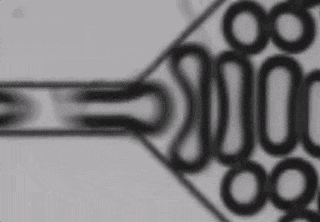
https://news2.rice.edu/files/2018/12/1210_BUBBLES-GIF-3-2fzzvfc.gif
An animated gif shows how bubbles generated in a microfluidic device “pinch” one another as they create a foam. Rice University engineers made the device to generate foam with bubbles in two or three distinct sizes. (Credit: Biswal Lab/Rice University)
Located on a 300-acre forested campus in Houston, Rice University is consistently ranked among the nation’s top 20 universities by U.S. News & World Report. Rice has highly respected schools of Architecture, Business, Continuing Studies, Engineering, Humanities, Music, Natural Sciences and Social Sciences and is home to the Baker Institute for Public Policy. With 3,962 undergraduates and 3,027 graduate students, Rice’s undergraduate student-to-faculty ratio is just under 6-to-1. Its residential college system builds close-knit communities and lifelong friendships, just one reason why Rice is ranked No. 1 for lots of race/class interaction and No. 2 for quality of life by the Princeton Review. Rice is also rated as a best value among private universities by Kiplinger’s Personal Finance. To read “What they’re saying about Rice,” go to http://tinyurl.com/RiceUniversityoverview.
